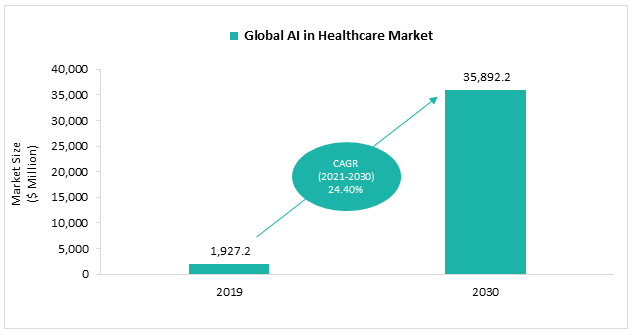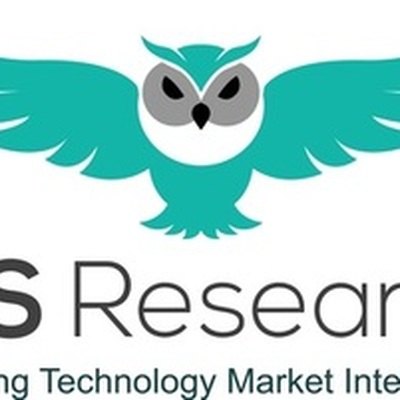Forums » News and Announcements
AI in Healthcare Market Growth Analysis
-
AI-enabled devices are used for augmenting care delivery, data management, diagnosis, and research, among other healthcare operations. Various technologies such as big data, augmented intelligence, multi-model data management, and artificial intelligence (AI), are being used for efficient data management. However, AI adoption is anticipated to be highest among all the data management technologies. Moreover, AI technology is anticipated to enhance the efficacy of clinician workflow, decision-making process, and administration workflow.
The global AI in healthcare market is anticipated to reach $35,892.2million by 2030, registering a CAGR of 24.40%, during the forecast period 2021-2030. Owing to the COVID pandemic, the market grew with a significant growth rate in 2020. The global lockdown and social distancing norms highlighted the importance of remote monitoring, telemedicine, and technology integration in the primary healthcare system, which accelerated the market growth in 2020. The following figure represents the global AI in healthcare market during 2019-2030.

Presently, AI adoption is high in few healthcare applications such as medical diagnosis and imaging, and data management. Moreover, AI adoption is being encouraged in telemedicine, remote monitoring and lifestyle management, and robot-assisted surgery.
COVID-19 Impact on Global AI in Healthcare Market
The onset of the COVID-19 pandemic has encouraged AI adoption in the global healthcare paradigm. The adoption of this technology has increased in developed and developing economies. However, lack of specific regulations and limited efficacy of AI in clinical environment is anticipated to limit AI adoption by the healthcare systems.
Few of the key developments completed during the COVID-19 pandemic are as follows:
- Infervision Medical Technology Co., Ltd, a China-based company, launched an AI-enabled diagnosis solution for COVID-19 in 2020.
- K Health, an Israel-based telemedicine company, raised $48 million in funding in February 2020. The company intends to utilize the funding for releasing telemedicine services in Spanish.
Market Dynamics
Market Growth Opportunities
- Enabling Care at Home: Remote Monitoring
AI integrated devices are making remote monitoring of patients feasible. AI integrated devices linked with mobile applications track and share medical data with physicians and suggest necessary action depending upon the patient situation. For instance, digital applications integrated with AI-enabled blood glucose monitors enable physicians to track the blood glucose levels of patients remotely. AI-enabled wearable devices such as smartwatches connected with digital applications can constantly track health vitals, enabling better lifestyle management.

• Capitalizing on Unmet Clinical Demand
• Leveraging Rapid Development in Deep Learning
• Unlocking the Combined Potential of AI and RoboticsMarket Restraints
• Lack of Clearly Defined Regulations
• Data Security and Privacy Concerns
• Barriers to Physician’s Adoption of AI
• Legal Implications of AI SystemsOpportunity Analysis
Developing countries such as China and India are anticipated to significantly benefit from the increasing acceptance by healthcare providers and patients regarding the adoption of AI-enabled healthcare solutions. Companies across the globe, as well as potential new entrants, are anticipated to target the developing countries as they remain largely untapped, especially in the case of healthcare applications such as telemedicine, remote monitoring, robot-assisted surgery, patient and provider data management, which have strong potential for future growth. Thus, with a growing preference for advanced technologies in developing countries, the market competition is likely to intensify, wherein leading companies are anticipated to differentiate their solutions based on the pricing and delivery models.
Key Companies in the Global AI in Healthcare Market
Some of the key players contributing to the global AI in Healthcare market include Activ Surgical, Inc., Atomwise, Inc., Babylon Health, BenevolentAI, Butterfly Network, Inc., Freenome, General Electric Company, International Business Machines Corporation (IBM), Koninklijke Philips N.V., Nuance Communications, Inc., Nvidia Corporation, Olive, Siemens Healthineers AG, Viz.ai, Inc., and Zebra Medical Vision Ltd.
Key Questions Answered in this Report:
• What are the key regulations governing AI adoption in healthcare across various regions?
• Which start-ups received significant funding in 2020?
• What has been the impact of the COVID-19 pandemic on global AI in healthcare market?
• What is the anticipated futuristic impact of COVID-19 on AI adoption in the global healthcare market?
• What are the opportunities for AI healthcare startups in healthcare sector during the COVID-19 pandemic?
• Who are the leading players in global AI in healthcare market?
• What are the key business models prevalent in global AI in healthcare market?
• What type of products are anticipated to be launched during the forecast period 2021-2030?
• What are the key market drivers, restraints, and growth opportunities for the market?
• What was the market size for the various product types in the global AI in healthcare market in 2020? How are the product types anticipated to grow during the forecast period 2021-2030?
• What was the market size for various AI-enabled applications in healthcare in 2020? Which application is anticipated to grow with the highest CAGR during the forecast period 2021-2030?
• What was the market size of AI technologies, such as machine learning, deep learning, natural language processing, and computer vision in 2020? How are the technologies anticipated to grow during the forecast period, 2021-2030?
• Which region contributes the major share to the global AI in healthcare market? Which region holds significant growth potential during the forecast period 2021-2030?Get Free Sample Report - https://bisresearch.com/requestsample?id=1068type=downl...
Key USPs of the Report
Following are some of the key contents of the report:
• Funding Scenario
This section encompasses a description of the current funding landscape in the global AI in healthcare space for key players.
• Technology Readiness Index
This section is intended to aid the readers in identifying novel technology opportunities.
• Business Model Analysis
This section comprises information on the key business models deployed in the market by leading players.
BIS Related Studies
Global Next Generation Implants (NGI) Market – Analysis and Forecast (2017-2023)
